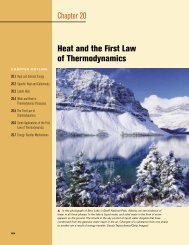15 • Oscillatory Motion - ECHSPhysics
15 • Oscillatory Motion - ECHSPhysics
15 • Oscillatory Motion - ECHSPhysics
You also want an ePaper? Increase the reach of your titles
YUMPU automatically turns print PDFs into web optimized ePapers that Google loves.
Oscillations and<br />
Mechanical Waves<br />
W<br />
e begin this new part of the text by studying a special type of motion called<br />
periodic motion. This is a repeating motion of an object in which the object<br />
continues to return to a given position after a fixed time interval. Familiar objects<br />
that exhibit periodic motion include a pendulum and a beach ball floating on the<br />
waves at a beach. The back and forth movements of such an object are called oscillations.<br />
We will focus our attention on a special case of periodic motion called simple<br />
harmonic motion. We shall find that all periodic motions can be modeled as<br />
combinations of simple harmonic motions. Thus, simple harmonic motion forms a basic<br />
building block for more complicated periodic motion.<br />
Simple harmonic motion also forms the basis for our understanding of mechanical<br />
waves. Sound waves, seismic waves, waves on stretched strings, and water<br />
waves are all produced by some source of oscillation. As a sound wave travels<br />
through the air, elements of the air oscillate back and forth; as a water wave travels<br />
across a pond, elements of the water oscillate up and down and backward and forward.<br />
In general, as waves travel through any medium, the elements of the medium<br />
move in repetitive cycles. Therefore, the motion of the elements of the medium bears<br />
a strong resemblance to the periodic motion of an oscillating pendulum or an object<br />
attached to a spring.<br />
To explain many other phenomena in nature, we must understand the concepts of<br />
oscillations and waves. For instance, although skyscrapers and bridges appear to be<br />
rigid, they actually oscillate, a fact that the architects and engineers who design and<br />
build them must take into account. To understand how radio and television work, we<br />
must understand the origin and nature of electromagnetic waves and how they propagate<br />
through space. Finally, much of what scientists have learned about atomic<br />
structure has come from information carried by waves. Therefore, we must first study<br />
oscillations and waves if we are to understand the concepts and theories of atomic<br />
physics. ■<br />
Drops of water fall from a leaf into a pond. The disturbance caused by the falling water<br />
causes the water surface to oscillate. These oscillations are associated with waves moving<br />
away from the point at which the water fell. In Part 2 of the text, we will explore the principles<br />
related to oscillations and waves. (Don Bonsey/Getty Images)<br />
PART<br />
2<br />
451



